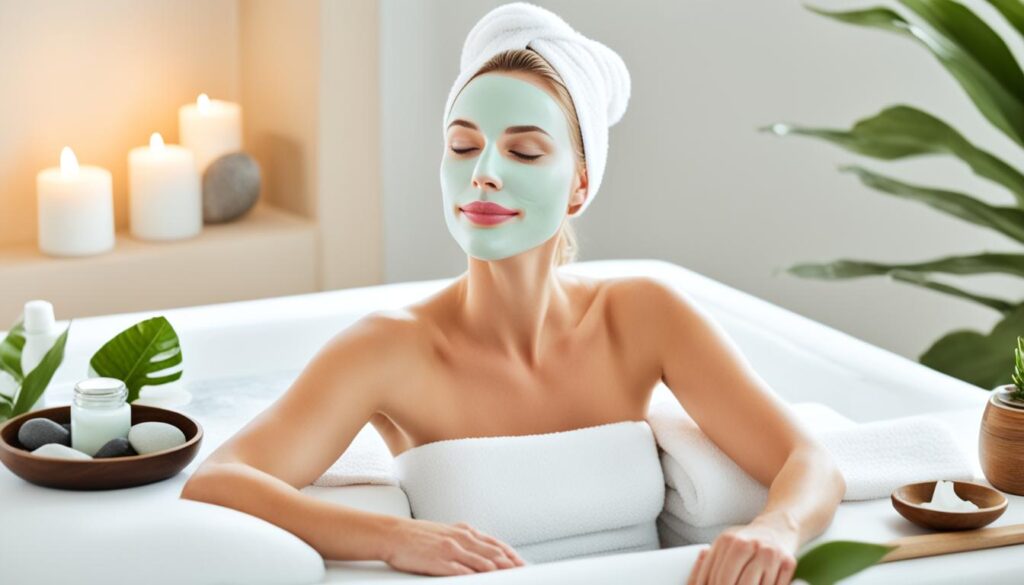
Here are 5 hyaluronic acid diy face masks for hydration to make at home. By making these masks at home, you not only get that moisture boost. You also get to reduce fine lines and add a glow to your skin. Plus, you know exactly what’s in them – no mystery ingredients here.
Let’s dive into making your own hyaluronic acid face masks that’ll make your skin oh-so-happy.
5 Hyaluronic Acid DIY Face Masks for Hydration
Getting hydrated skin is now easy and cheap with these homemade hyaluronic acid masks. They use the humectant power of hyaluronic acid for spa-like results at home. You can make a face cream, an eye gel, and a lotion for after sun to fit your needs.
Hyaluronic acid is key for keeping your skin hydrated. These DIY masks do wonders for your skin without costing a lot. They make your skin look young and fresh. You’ll love making these face mas

1. Hyaluronic Acid-Infused Plumping Face Cream
This face cream is packed with hyaluronic acid for moisture. It also has shea butter and aloe vera to help your skin. Use it on clean skin for a boost that makes you look younger.
2. Soothing Hyaluronic Acid Eye Gel
- Reduce the look of puffiness and dark circles with this eye gel.
- This gel has calming chamomile and vitamin C to brighten your eyes.
- It feels nice and cold when you gently tap it around your eyes.
3. Hydrating After-Sun Lotion
This lotion calms sunburn and keeps skin wet. Aloe vera and glycerin help hyaluronic acid dyi face mask for hydration soothe your skin after too much sun. Apply a bit to feel moisture bounce back into your skin.

4. Brightening Hyaluronic Acid Face Mask
Give your skin a bright look with this face mask.
It has vitamin C and turmeric to even out your skin for a glow.
Keep it on for 15-20 minutes and wash your face for a fresh look.
5. Hydrating Hyaluronic Acid Sleeping Mask
Get up to soft, full skin with this night mask. It uses rich oils and hyaluronic acid to keep moisture in while you sleep. Wake up to skin that’s bright and full of life.
Essential Ingredients for Homemade Hyaluronic Acid Face Masks
When you make your own hyaluronic acid face masks, start by picking the correct base. You need the right hydrogel base for the mask’s texture and feel. Collagen, gelatin, and agar agar are natural choices for this.
Each of these choices affects how your mask feels. The mask’s final properties like how well it stretches, spreads, and feels on the skin depend on this.

Choosing the Right Hydrogel Base: Collagen, Gelatin, or Agar Agar
Collagen is a great pick because it gives the mask a soft, smooth texture. This aids in plumping and tightening the skin. Gelatin, though, makes a mask that’s more flexible and spreads easily, ensuring a comfortable wear.
Agar agar is unique. It offers a more solid texture and is perfect for masks that focus on specific areas.
Think about what you want your mask to do for your skin. Also consider how you want it to feel. Mixing and matching these base ingredients can help find the right fit for your DIY hyaluronic acid mask.
“Collagen, gelatin, and agar agar are all natural polymers that can be used to create a gel-like matrix for homemade hyaluronic acid face masks.”
The correct hydrogel base is essential for your DIY hyaluronic acid mask to work well. Understanding what each base offers helps you meet your skin care goals. It lets you tailor your masks to what your skin really needs.

Step-by-Step Guide to Creating Your Own Hyaluronic Acid Face Mask
Creating a homemade hyaluronic acid face mask is easy and fun. You get to choose what goes in it. This means you can make a mask that’s perfect for your skin, giving you a moisturized and nourished glow. Let’s go through how to make one.
Start by making your chosen hydrogel base. This could be collagen, gelatin, or agar agar. After you pick your base, mix in the hyaluronic acid.
- Get the right amount of hyaluronic acid powder and mix it into your base gently. Keep stirring until it’s all mixed well.
- If you want extra benefits, add in some botanical extracts or essential oils. Pick things that will help your skin.
- After mixing everything, pour the mixture into a mold evenly.
- Let the mask cool according to your base’s directions.
Now, your mask is ready to use. Take it out of the mold and apply it on your face. Let it sit for the time suggested.

Make your homemade hyaluronic acid face mask work better by preparing your skin right. Cleanse and tone your face for a fresh start. This helps the mask’s goodness seep in and hydrate the skin well.
Then, put the mask on smoothly, ensuring you cover the whole face. Want more hydration? Try a hyaluronic acid serum under the mask. It pushes moisture deep into your skin.
Layering Techniques and Proper Sealing for Optimal Results
After applying the mask, use a moisturizer or oil to seal in moisture. This keeps the hydration locked in and stops it from disappearing too fast. The right steps for layering and sealing your mask make a big difference in how well it works.
- Start with a clean, toned canvas
- Apply mask in an even layer, covering the entire face
- Layer a hyaluronic acid serum under the mask for deeper hydration
- Seal in moisture with a moisturizer or facial oil on top
WATCH THIS VIDEO ON HOW TO MAKE A ROSE HYALURONIC DYI ACID Face MASK
FAQ
What are the key benefits of using hyaluronic acid in DIY face masks?
Hyaluronic acid is great at holding water. It can boost skin’s hydration, making it look plump and smooth. Using it in DIY masks can also make your skin more radiant and protect its natural barrier.
How do levels of hyaluronic acid in the skin change as we age?
As we get older, our skin has less hyaluronic acid. This means it’s more prone to dryness and early signs of aging. Bad habits like exposure to UV rays and smoking can speed up this process. This leads to dry, wrinkly, and dull skin.
What types of hydrogel-forming ingredients can be used in homemade hyaluronic acid face masks?
Choosing the right hydrogel base is key for a good hyaluronic acid mask. You can use natural polymers like collagen, gelatin, and agar agar. They create a gel that can hold the hyaluronic acid and other helpful ingredients. Each base material affects how the mask feels on your skin.
How can you maximize the hydrating benefits of a DIY hyaluronic acid face mask?
Before using a hyaluronic acid mask, cleanse and tone your face. Apply the mask evenly. For extra hydration, use a hyaluronic serum first and a moisturizer or oil last. This locks in the moisture.
What other nourishing ingredients can be added to customized hyaluronic acid face masks?
You can add more than just hyaluronic acid to your mask. Try botanical extracts and oils like aloe vera, green tea, and chamomile. or vitamin C-rich fruit extracts. Oils like jojoba and rosehip seed add extra moisture and nutrients.
2 Hyaluronic Acid Products for Making the Best Face Mask
The Ordinary Hyaluronic Acid 2% + B5
The Ordinary’s Hyaluronic Acid 2% + B5 is loved by many. It’s packed with hyaluronic acid to deeply moisturize and soften your skin. Add B5, and your skin gets even more moisture, looking brighter and smoother. You can use this serum alone or mix it into your DIY mask for a spa-like treat.
Glossier Hyaluronic Acid Milky Cleanser
Glossier’s Hyaluronic Acid Milky Cleanser is great for a gentle, yet powerful, face mask. It cleans while deeply hydrating with hyaluronic acid and other moisturizers. When you use it in your DIY mask, it keeps the moisture locked in. This leaves your skin looking full and glowing.
CONCLUSION:
- You have learned 5 DIY face masks featuring hyaluronic acid for skin hydration
- Understand the benefits of hyaluronic acid as a powerful humectant
- Learn how to create homemade facial treatments for a radiant complexion
- Explore natural and nourishing ingredients for anti-aging skincare
- Pamper your skin with easy-to-make hyaluronic dyi acid face masks a
